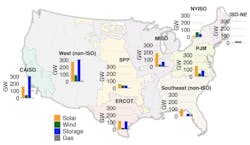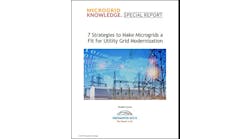A recent report from Lawrence Berkeley National Lab (LBNL) has confirmed that interconnection queues continue to be long – and those delays are significantly hampering completion rates for renewable energy infrastructure projects across the country.
Regional grid operators and utilities require grid-connected energy projects to undergo a series of impact studies prior to the start of construction to determine what, if any, transmission equipment or equipment upgrades are required. The evaluation process, which also determines the cost of the equipment, can take a year or more.
Everything from a solar carport to large-scale solar and wind farms must submit designs for evaluation if the project is to be connected to the grid.
The problem is that the interconnection queues are like the lines for the hottest ride at Disney World or Universal Studios – long and slow moving. The difference is that these lines, unlike those in amusement parks, take months or years to navigate, not minutes or hours.
Interconnection queues slowing down renewable adoption
According to LBNL’s most recent annual briefing on interconnection, Queued Up: 2024 Edition, the time from interconnection request to commercial operation is growing.
In 2008, wait times were around two years. By 2015, that had crept up to about three years.
By 2023, wait times stretched to nearly five years.
That does not bode well for the nearly 12,000 projects currently seeking interconnection. There is a total of 1,570 GW of generator capacity and 1,030 GW of storage capacity in queues across the country, according to the brief.
Nearly all (95%) of the queued capacity is from solar, storage and wind projects with 1,480 GW being zero-carbon generation. More than 80% of the capacity entering the queue in 2023 were solar and battery storage projects.
Interconnection issues slow energy transition
Long interconnection delays have a ripple effect across the entire energy transition landscape with the impact felt in well-established markets, such as wind and rooftop solar, as well as in emerging markets like electric vehicle (EV) charging.
Aron Bowman, president of ELM Microgrid and ELM Solar, recently told Microgrid Knowledge that interconnection issues are among the biggest headwinds today facing EV adoption and EV charger infrastructure growth in the country.
EV charging stations cannot be simply dropped in front of a building and plugged in, he explained. If you have a building that traditionally draws 250 kW of power and you add 20 EV chargers to the mix, you could well be doubling or tripling the load and the utility has to be able to support that increase, Bowman said.
“Oftentimes that feed doesn't exist from the utility and requires a very serious upgrade. So, the utility wants to take a year or two to do a study and charge you to upgrade the grid into your facility, [plus] you have to invest in additional switch gear and equipment,” he said. “It's a real challenge.”
If the interconnection queues can be overcome, grid-connected renewable microgrids could help solve the challenges with building out a charging infrastructure that can support the coming wave of EVs.
A solar microgrid system could not only directly charge EVs with electricity generated by the on-site array, but bidirectional technologies also enable the EV’s batteries to become an additional energy resource for the grid during times of peak demand.
The path forward
LBNL reports that only 19% of all projects that requested interconnection between 2000 and 2018 were operational by 2023, with completion rates of 14% for solar and 11% for battery projects.
Theories abound around what can be done to solve the interconnection queue challenge, though some are opting to skip it altogether by constructing off-grid microgrids. A number of data centers and large industrial operations have made that choice recently to ensure they get the resilience, reliability and energy cost savings they desire in a timely manner.
The U.S. Department of Energy (DOE), for its part, released a new road map this month that outlines 35 solutions it believes will help solve the backlog and meet the growing demand for renewable energy resources.
The Transmission Interconnection Roadmap, developed by the DOE’s Interconnection Innovation e-Xchange (i2X), aims to improve the process for connecting clean energy projects to the grid by 2030.
The road map is organized around four goals to “enable a simpler, faster and fairer interconnection of clean energy resources while enhancing the reliability, resiliency and security of our electric grid,” according to the DOE.
“Clearing the backlog of nearly 12,000 solar, wind and storage projects waiting to connect to the grid is essential to deploying clean electricity to more Americans,” said Jennifer Granholm, secretary of the U.S. Department of Energy. “Through the i2X program, the Biden-Harris administration is accelerating the interconnection process by ensuring all stakeholders have better access to data and improved standards and procedures as we seek to develop and maintain a more efficient, reliable and clean grid.”
The solutions outlined in the road map address projects already in the interconnection queues, create new options for fast-tracking interconnection, suggest adopting a comprehensive set of requirements and standards, and promote exploring options for separating the interconnection process from network upgrade investments.
The DOE will be hosting a webinar on the targets and solutions presented in the road map on May 8.









